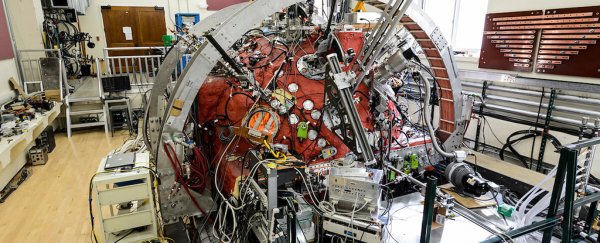The spinning ball of plasma that is our Sun produces a spinning magnetic field too, and where that magnetic field weakens, solar winds can escape.
Now scientists have been able to recreate those same effects in a lab for the first time, meaning we can study the bizarre science around our star at close quarters, without a trip across the Solar System.
Knowing how this magnetic field and its associated plasma flows behave is crucial in improving our understanding of how and when solar storms might impact Earth, and potentially put our communications systems and infrastructure under severe strain.
In particular, the mini-Sun setup now configured inside a lab at the University of Wisconsin-Madison maps the wider effects of the Parker spiral (named after its discoverer, American solar astrophysicist Eugene Parker). Specifically, this is the way that the Sun's magnetic field and its solar winds flow out like a ballerina's skirt across the surrounding planets.
"The solar wind is highly variable, but there are essentially two types: fast and slow," says physicist Ethan Peterson from the University of Wisconsin-Madison.
"Satellite missions have documented pretty well where the fast wind comes from, so we were trying to study specifically how the slow solar wind is generated and how it evolves as it travels toward Earth."
To investigate the Parker spiral and its solar winds further, Peterson and his colleagues created the Big Red Ball: a hollow plasma-containing sphere three metres (nearly ten feet) wide, featuring a strong magnet and its centre and various measurement probes.
Helium gas was then ionised to create plasma at temperatures of 100,000 degrees Celsius (180,032 degrees Fahrenheit), before the whole mixture was spun using an electric current and the magnetic forces inside the machine.
What scientists ended up with is a miniature Parker spiral that can be continually monitored in three dimensions.
"Satellite measurements are pretty consistent with the Parker spiral model, but only at one point at a time, so you'd never be able to make a simultaneous, large-scale map of it like we can in the lab," says Peterson. "Our experimental measurements confirm Parker's theory of how it is created by these plasma flows."
As well as measuring the stretches and twists of the Sun's magnetic field, which haven't been extensively explored before, the Big Red Ball has also been able to generate its own plasma 'burps' – small shoots of plasma that fuel the slower solar winds.
For the first time, scientists have been able to take a detailed look at how they're actually generated, as high-speed plasma meets weakened points in the magnetic field.
While this small-scale Parker spiral can't fully replicate the real thing stretching out across space, it's certainly going to help researchers figure out some of the physics behind how the Sun's magnetic field and plasma cycles operate – and what we can expect from them in the future.
The researchers stress that it by no means removes the need for solar probe missions in the future: the Parker Solar Probe for example, launched in August 2018, is on its way to the Sun. It's going to dip below the Alfvén surface – the point on the solar surface where solar winds are first born – to measure these solar winds in greater detail than ever before.
In the meantime, the Big Red Ball is now available for other researchers to make use of, run tests through, and take measurements from – a potentially crucial resource in understanding more about our Solar System.
"Our work shows that laboratory experiments can also get at the fundamental physics of these processes," says Peterson.
"And because the Big Red Ball is now funded as a National User Facility, it says to the science community: If you want to study the physics of solar wind, you can do that here."
The research has been published in Nature Physics.
